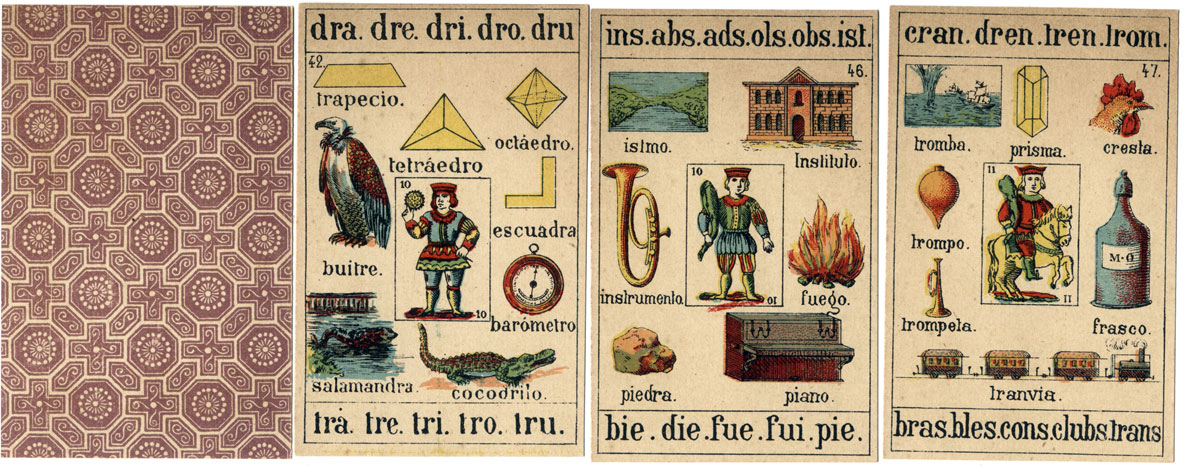Jaime Margarit - Recreo Infantil
'Recreo Infantil' children's educational cards published by Jaime Margarit, Palamós (Gerona) c.1888.
Educational playing cards have of course been around for several centuries, and are not new. Jaime Margarit of Palamós, Gerona (Spain) registered a patent for a new pack of “Naipes Instructivos” (Instructional playing-cards) in 1888. As can be seen, each card shows a letter or syllable in the top corners, vowel permutations for consonants, a series of images whose names in Spanish commence with that letter or syllable, and a miniature playing card in the centre. The images include animals, geometrical forms and other edifying objects. The wrapper and Ace of Coins state that Jaime Margarit was a Bachelor of Arts and Senior Teacher. The Ace of Coins also shows two children studying with allegories of learning.

Above: 'Recreo Infantil' children's educational cards published by Jaime Margarit, Palamós (Gerona) c.1888. 48 cards in paper wrapper. Quite a lot of these decks appear for sale on the Internet in new condition, leading one to suppose that they were unsold in their day.
A great fashion for educational playing cards had spread from France to Holland, Germany and England during the seventeenth century. They have been popular ever since. For comparison see also: Logica Memorativa by Thomas Murner, 1507 • Robert Morden's Map Cards, 1676 • Arms of English Peers, 1686 • Proverbial Cards, 1698 • Mechanical Instruments, c.1700 • Geistliche Karten, 1718 • Cartes Questions-Devinettes, c.1840 • Happy Families • Jaques' Illustrated Proverbs, c.1885 • Japanese Uta Garuta • Children's Maxim Cards from Uruguay • Change for a Shilling, c.1930 • Indian Alphabetical Cards, c.1940 • Wild Flower Sevens card game, 1960 • Snip Snap, 1968 • Learn Thai Playing Cards, 2009 •

By Simon Wintle
Member since February 01, 1996
I am the founder of The World of Playing Cards (est. 1996), a website dedicated to the history, artistry and cultural significance of playing cards and tarot. Over the years I have researched various areas of the subject, acquired and traded collections and contributed as a committee member of the IPCS and graphics editor of The Playing-Card journal. Having lived in Chile, England, Wales, and now Spain, these experiences have shaped my work and passion for playing cards. Amongst my achievements is producing a limited-edition replica of a 17th-century English pack using woodblocks and stencils—a labour of love. Today, the World of Playing Cards is a global collaborative project, with my son Adam serving as the technical driving force behind its development. His innovative efforts have helped shape the site into the thriving hub it is today. You are warmly invited to become a contributor and share your enthusiasm.
Related Articles

Pierre Varangot
Tracing the origins, legality and legacy of Pierre Varangot’s San Sebastián deck.

Archaic Spanish-suited pattern from Bayonne
Archaic Franco-Spanish pattern from Bayonne by a manufacturer with the initals M.V.

Scientific Whist
“Scientific Whist” : standard cards with instructions for play on the faces by Chas Goodall & Son, 1...

Historic Shakespeare
“Historic Shakespeare” playing cards featuring Shakespearean characters by Chas Goodall & Son.

Heartsette by Herbert Fitch & Co, 1893
A glimpse into a busy print and design office in late Victorian London.

Rap Rummy
Rap Rummy made by Parker Brothers in 1926, only 4 years after the discovery of King Tutankhamen’s to...

German Travel Cards
A travel-themed educational deck helping American tourists visiting Germany.

Can You Believe Your Eyes?
“Can You Believe Your Eyes?” playing cards featuring visual illusions & other oddities.

Tarot de las Coscojas
Historical playing card design, tarot symbolism and an almost psychedelic medieval surrealism.

The European Interchanges Quartets
A card game based around motorway intersections from European countries.

Tarot de Valverde de la Vera
A series of 24 surrealist engravings by Mexican artist Claudio Favier in which archetypal Tarot alle...

Love Tests
Vintage novelty “Love Test” cards of a slightly saucy nature but all in good fun!

Briefmarken-Quartett
Quartet game featuring postage stamps from the Zones of Occupation in post-WWII Germany.

Doctor Who Trump Card Game
Game for two players in which Doctor Who and the Legendary Legion join battle with the Alien Hordes....

Baraja de Juan Martín Zamorano
Deck inspired by El Pendón de los Zamorano, a military pennant dating from 1501, published by Priego...

Heráldica Castanyer No. 16
Strange variant of international pattern cards for poker or bridge.
Most Popular
Our top articles from the past 28 days







